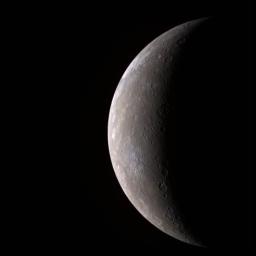One week ago, the MESSENGER spacecraft transmitted to Earth the first high-resolution image of Mercury by a spacecraft in over 30 years, since the three Mercury flybys of Mariner 10 in 1974 and 1975. MESSENGER's Wide Angle Camera (WAC), part of the Mercury Dual Imaging System (MDIS), is equipped with 11 narrow-band color filters, in contrast to the two visible-light filters and one ultraviolet filter that were on Mariner 10's vidicon camera. By combining images taken through different filters in the visible and infrared, the MESSENGER data allow Mercury to be seen in a variety of high-resolution color views not previously possible. MESSENGER's eyes can see far beyond the color range of the human eye, and the colors seen in the accompanying image are somewhat different from what a human would see.
The color image was generated by combining three separate images taken through WAC filters sensitive to light in different wavelengths; filters that transmit light with wavelengths of 1000, 700, and 430 nanometers (infrared, far red, and violet, respectively) were placed in the red, green, and blue channels, respectively, to create this image. The human eye is sensitive across only the wavelength range 400 to 700 nanometers. Creating a false-color image in this way accentuates color differences on Mercury's surface that cannot be seen in the single-filter, black-and-white image released last week (see PIA10179).
This visible-infrared image shows an incoming view of Mercury, about 80 minutes before MESSENGER's closest pass of the planet on January 14, 2008, from a distance of about 27,000 kilometers (17,000 miles).
Image sequences acquired through the 11 different MDIS filters are being used to distinguish subtle color variations indicative of different rock types. By analyzing color differences across all 11 filters, the MESSENGER team is investigating the variety of mineral and rock types present on Mercury's surface. Such information will be key to addressing fundamental questions about how Mercury formed and evolved.
Mercury has a diameter of about 4880 kilometers (3030 miles), and the smallest feature visible in this color image is about 10 kilometers (6 miles) in size.
Mission Elapsed Times (MET) of images: 108820022, 108820037, 108820057
These images are from MESSENGER, a NASA Discovery mission to conduct the first orbital study of the innermost planet, Mercury. For information regarding the use of images, see the MESSENGER image use policy.

 Planetary Data System
Planetary Data System












